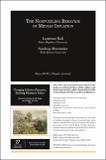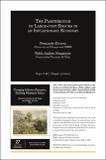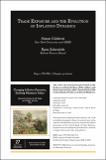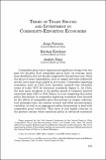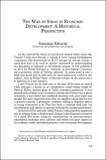Buscar
Mostrando ítems 71-80 de 323
The nonpuzzling behavior of median inflation
For decades, textbooks have explained inflation behavior with
Friedman (1968)’s Phillips curve: the inflation rate depends on
expected inflation and the deviation of unemployment from its natural
rate. Yet this theory has always been controversial, and skepticism
has been rampant in the decade ...
The passthrough of large-cost shocks in an inflationary economy
This paper surveys and modestly extends the theory of menu-cost
models of the behavior of the aggregate price level after large-cost
shocks. It does so in the context of an economy with a high underlying
rate of inflation. It concentrates on the effect of large permanent and
unexpected increases ...
Trade exposure and the evolution of inflation dynamics
The Phillips curve—the relationship between price inflation
and fluctuations in economic activity— is a central building block
of economic models that allow for nominal rigidities and are relied
upon by central banks around the world to gauge cyclical inflationary
pressures and forecast inflation. ...
The three E’s of central-bank communication with the public
Central banks used to ask, “Shall we communicate this?” Now, as a rule, they ask, “Why wouldn’t we communicate this?” This
first wave of the revolution in central-bank communication is giving rise to a second wave. The question increasingly is, “How should we communicate this in a way that engages a ...
The transformation and performance of emerging market economies across the great divide of the global financial crisis
Before the Global Financial Crisis, a drive towards greater central-bank autonomy and transparency, as part of the achievement of greater central-bank credibility that had begun in the advanced economies (AE), spread to the emerging market economies (EME). This process was greatly enhanced by the ...
Fiscal inflation and cosmetic defaults in a small open economy
For a small open economy, maintaining a stable exchange rate and moderate levels of inflation is often a goal of primary importance. At the same time, the profession has recognized the tight link between fiscal and monetary policies in determining inflation dynamics. Thus, the goal of a stable exchange ...
The fiscal footprint of macroprudential policy
Monetary policies leave a fiscal footprint. When the central bank cuts the policy interest rate, this footprint comes through multiple
channels: The demand for currency rises, so the central bank prints more banknotes to accommodate it, and this creates seignorage revenues. Inflation unexpectedly ...
Inflation targeting under political pressure
Historically, many emerging economies, particularly in Latin America, battled against persistently high and volatile inflation. Today, emerging economies continue to experience higher inflation than developed ones, and their central banks deviate more frequently from inflation targets. These patterns ...
Terms of trade shocks and investment in commodity-exporting economies
Commodity prices have experienced significant swings over the past two decades. Real commodity prices have on average more than doubled in the last decade compared to the previous one while the prices of some commodities such as copper and other industrial metals have more than tripled in real terms. ...
The war of ideas in economic development: a historical perspective
In the early 1970s when he had barely turned thirty years old Vittorio Corbo was already a legend of sorts among development economists. His dissertation at M.I.T. became an instant classic a work that had to be read by anyone interested in understanding the dynamics of inflation in developing nations. ...

